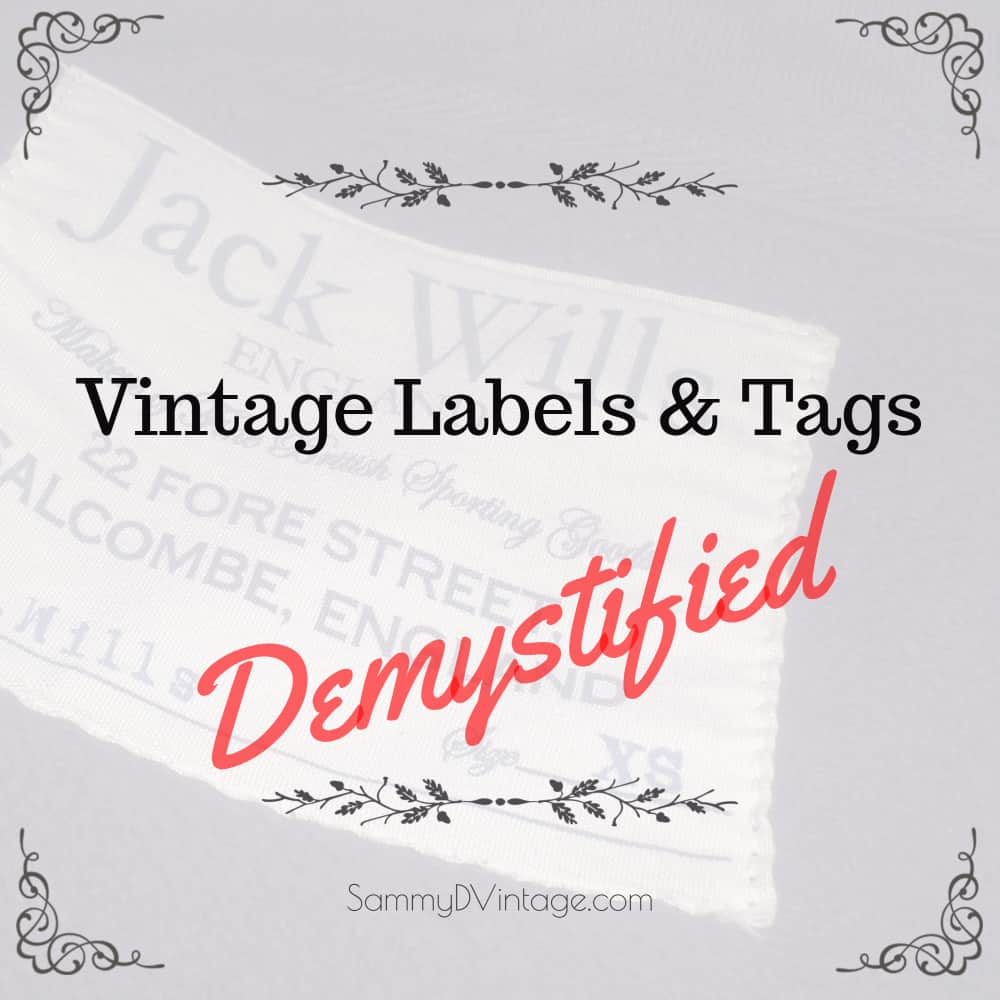
Your fingers stroke the fabric along a garment’s back and neck, hoping to find a label or tag and your much-needed clue to its vintage authenticity.
Your search comes up empty, so you turn the garment inside out to look along the side or bottom seam.
“A-ha!” you squeal.
A label was sewn into the bottom side seam, a square of fabric that, while tiny, is a huge source of information for performing the important detective work a good vintage lover knows and loves: Dating the era of one’s vintage piece!
Over a year ago, I shared my “How to Tell It’s Vintage by Labels & Tags.”
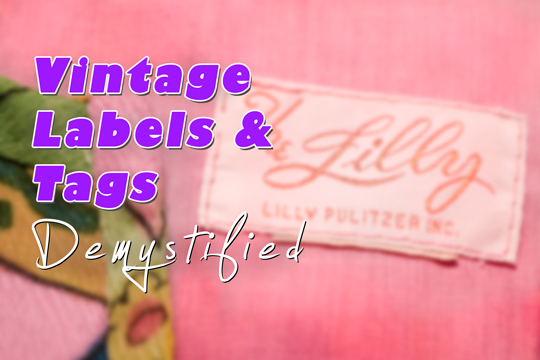
The story was such a hit that it inspired me to write stories on how union labels and the construction of your vintage garment can help when determining a garment’s era and fashion history.
This article is your go-to reference for tips and tricks to reveal a garment’s probable vintage era based on the details of its labels and tags alone!
Not all vintage pieces have a label or tag, however — especially if it was handmade, which vintage prior to the 1980s often was.
Be sure to visit my How to Date Clothing as Vintage article for tips beyond the tag.
3 Reasons You Should Buy Vintage Clothing Labels

Before we dig deep into the vintage labels and their unique characteristics, consider this a reminder of why vintage clothing labels are superior to modern-day clothes:
- Unique style
- Sustainable fashion
- High-quality craftsmanship
Now that I’ve grabbed your attention. we can proceed.
Vintage Clothing Labels
Feel free to scroll through the post to read these 13 tips for using your garment’s tag to help identify its vintage era, or click any of the links below to be taken immediately to the text within the article!
Let’s get into it, folks!
Vintage Clothing Label #1: COPYRIGHT
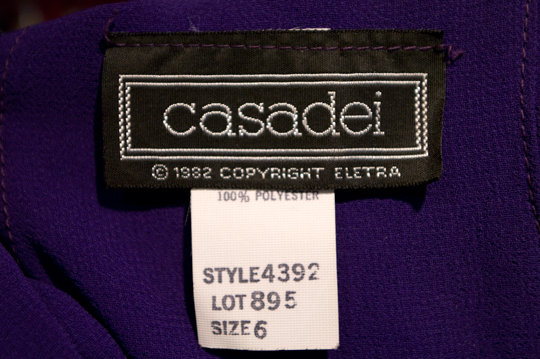
LOOK FOR … the most obvious – A copyright year. This is usually found on the vintage label itself or sometimes on a small tag attached to the label.
HOW OLD?
Usually, the same as or close to the year on the label. For example, if you see a label that says “© 1978”, you can assume that the garment was made around that time or within a few years.
NOTE:
When thrift store shopping, be careful not to confuse the copyright date with the actual production date of the garment. Sometimes, a brand or logo may be registered years before it is used on clothing or may continue to be used long after the registration date.
For instance, a label on a vintage dress that says “© 1950” could belong to a piece from the 1950s, 1960s, or even later.
WHY IT’S VINTAGE:
According to the industry standard, any garment with a label from 1992 or earlier is considered vintage. So, if you find a copyright year that matches this criterion, you have a strong clue for dating your garment!
This is especially helpful when the vintage labels do not have any other information, such as country of origin, fabric content, or care instructions.
Vintage Clothing Label #2: MADE IN U.S.A.
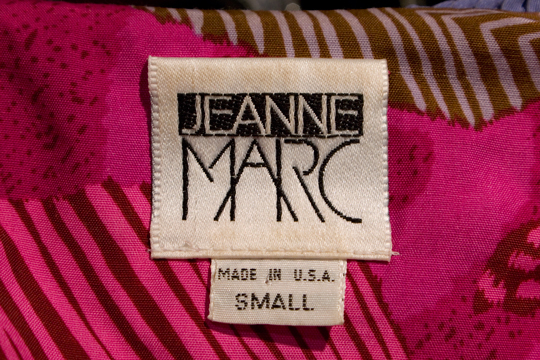
LOOK FOR … “Made in U.S.A.” or American flag design on or near the garment’s brand tag. The words should be easy to see and not tucked behind the tag. Sometimes, the label may also say “Union Made” or have a union label next to it.
HOW OLD?
Mostly 1980s, but could also be from the 1970s or even earlier. This is because the U.S.A. was a major producer of clothing until the late 20th century when many manufacturers moved their operations overseas to cut costs and increase profits.
WHY IT’S VINTAGE:
While statistically speaking, I don’t have the numbers to back it up, we can all agree that it is rare to find clothing that is made in the U.S.A., as most of it is imported from other countries, especially China, India, Bangladesh, and Vietnam. Therefore, finding a label that says “Made in U.S.A.” can be a hint for a vintage item.
Also, the location of the country of origin on a modern label is usually behind the tag, not on the front, like on this 1980s Jeanne Marc label. This is another way to tell vintage labels and tags apart from modern ones.
Vintage Clothing Label #3: NO ZIP CODES
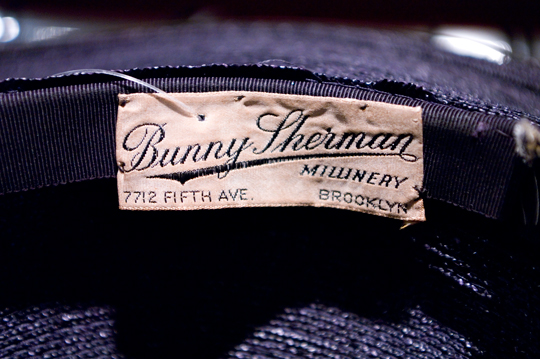
LOOK FOR … a store’s address without a zip code. Sometimes, the address may also include the state abbreviation or the city name.
HOW OLD?
Pre-1963.
Vintage clothes from the pre-1963 era exude a beauty that captivates fashion enthusiasts even today. Each garment tells a story of a bygone era with its intricate detailing, high-quality craftsmanship, and timeless elegance.
The designs showcase a unique blend of sophistication and charm, evoking nostalgia and a sense of romanticism. Whether it’s the classic silhouettes, luxurious fabrics, or exquisite embellishments, vintage clothes embody an aura of grace and refinement that modern fashion often seeks to emulate.
These treasured pieces not only celebrate the artistry of the past but also serve as a living testament to the enduring allure of fashion through the ages.
WHY IT’S VINTAGE:
Zip codes weren’t invented until 1963 when the growth of America made it necessary to institute zip codes for the postal service to more easily track addresses. Before that, addresses only had the street name and number, and sometimes the state or city.
Today, (Manhattan) New York, has more than 40 different zip codes. Clearly, “De Pinna” wasn’t aware of theirs when they made this garment before 1963!
RESOURCE: The history of zip codes.
Vintage Clothing Label #4: WOOLMARKS
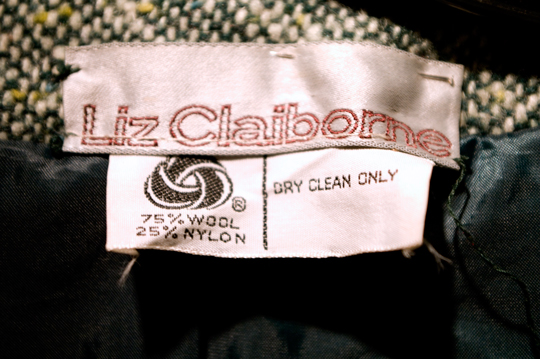
LOOK FOR … either the absence of, or the design of a “Woolmark” logo, as it serves as a hallmark of fine craftsmanship and enduring style.
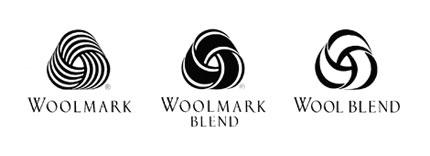
HOW OLD?
If you come across a made-from-wool vintage garment without any label identifying it as wool, chances are it predates 1939, adding a touch of mystery to its historical allure.
Garments featuring the first Woolmark logo, boasting 100% wool, place their origin no later than 1964, while those with the second logo, indicating 60% wool, hail from no earlier than 1971. Similarly, if you spot a vintage clothing piece with the third logo, symbolizing 50% wool, it can be dated no further back than 1999.
WHY IT’S VINTAGE:
The Woolmark logo was first placed on the tags of wool clothing in 1964 as a marketing technique to encourage consumers to buy the natural fiber of wool over synthetic polyester and acrylic. This elegant emblem soon became synonymous with top-notch quality and unparalleled sophistication, captivating fashion enthusiasts around the globe.
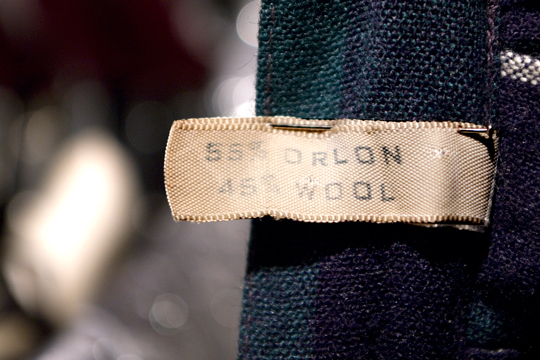
NOTE:
While the Woolmark is undoubtedly iconic, not all woolen garments wear this prestigious emblem. Why, you ask? It’s a matter of licensing and costs; displaying the Woolmark comes with a price tag, making it an exclusive addition to some vintage pieces. But don’t let the absence of the emblem deter you, for true vintage treasures often lie hidden beyond the label.
RESOURCE: The Vintage Fashion Guild’s Woolmark guide.
Vintage Clothing Label #5: MATERIAL NAMES
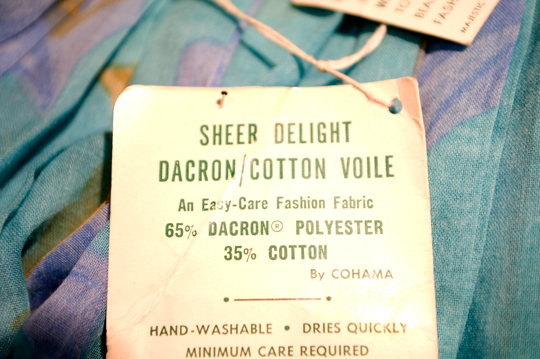
LOOK FOR … the type of material noted on a garment, particularly if it has an unusual name like “Dacron Polyester.”
HOW OLD?
To unravel the fabric of time, focus on the following vintage materials:
Dacron Polyester: If you stumble upon vintage garments labeled with “Dacron Polyester,” you’ve struck gold from the years 1958 to 1970, a remarkable period of fashion history.
Polyester: The invention of polyester dates back to 1941, but its commercial use took off in 1953. The heyday of polyester fashion was during the 1970s and beyond. Look for vintage monikers like “Celanese,” “Kodel,” and “Vycron”.
Nylon: An early pioneer, Nylon entered the commercial scene in 1939. Keep an eye out for the vintage name “Qiana Nylon,” a hallmark of garments from approximately 1968 to the 1970s.
Lycra (Spandex): The invention of Lycra in 1959 revolutionized stretchy fabrics. Known interchangeably as “Spandex,” it brought newfound comfort and flexibility to fashion.
Acrylic: Commercially introduced in 1950, acrylic also boasts a collection of vintage names like “Orlon,” “Acrilan,” “Zeran,” and “Creslan.”
WHY IT’S VINTAGE:
The invention of synthetics during World War II was an exciting time for American fashion — and for the clothing companies themselves!
This was an era of innovation, and the likes of DuPont introduced these materials with captivating marketing names. The inclusion of trade names like “Qiana Nylon” instead of a simple “Nylon” or “Dacron Polyester” rather than just “Polyester” added an irresistible allure, enticing consumers to embrace these novel fabrics.
RESOURCE: Fabric Link’s history of materials.
Vintage Clothing Label #6: COUNTRIES THAT NO LONGER EXIST
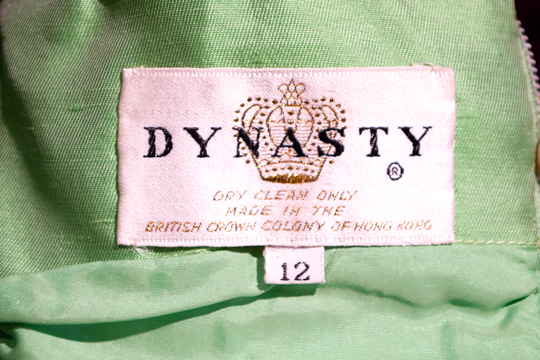
LOOK FOR … on the intriguing vintage clothing tags bearing the names of countries or colonies that have long vanished from modern maps.
HOW OLD?
Countries that no longer exist labels are from before 1999 when the last major change in the world map occurred. That was when the British Colony of Hong Kong returned to China after 156 years of British rule.
WHY IT’S VINTAGE:
While garments dating back to 1999 may not immediately qualify as vintage clothes, the true allure lies in identifying those labels that hark back to countries like “Yugoslavia.” In the early 1990s, the once-unified Yugoslavia underwent a profound transformation, splintering into the sovereign nations of Bosnia, Croatia, Macedonia, Serbia and Montenegro, and Slovenia.
Therefore, if you own a label with a country that no longer exists, you can be sure that your vintage dating clothing piece is from before 1999 or earlier.
RESOURCE: Missing Countries guide of About.com.
Vintage Clothing Label #7: HALF SIZES
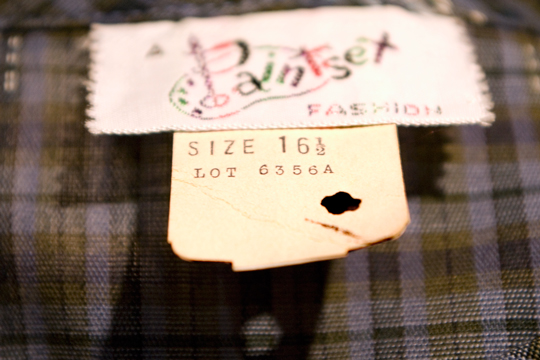
LOOK FOR … the presence of “half” sizes, gracefully represented by a fractional after the whole number size, such as 16 1/2. This detail may seem insignificant, but it actually reveals a lot about the age and style of the garment.
HOW OLD?
Pre-1970s and no older than the 1940s.
Pre-1970s vintage clothes, especially those dating back to the 1940s, often feature “New Look” silhouettes introduced by Christian Dior in 1947. These designs emphasized a nipped-in waist, full skirts, and a feminine aesthetic, marking a significant departure from the more austere styles of the war years.
The “New Look” revolutionized fashion and remains an iconic representation of post-war elegance and optimism. On a similar note, vintage garments from the 1960s were heavily influenced by the cultural and social shifts of the decade, with the advent of the “Swinging Sixties” bringing bold colors, psychedelic prints, and experimentation with hemlines. The mod fashion movement, popularized by figures like Twiggy, embraced geometric patterns and sleek, streamlined silhouettes, showcasing a dynamic and revolutionary spirit that continues to inspire contemporary fashion trends.
WHY IT’S VINTAGE:
According to one of my sources, half sizes were introduced in the 1940s as a way to accommodate “shorter” women who needed a different length than the standard sizes. The half size indicated that the garment was shorter in the waist, bust, and hip measurements and also had narrower shoulders and shorter sleeves.
The reason why half sizes were written with an even whole number and “1/2” was because odd numbers were reserved for junior sizes, which at that time referred to petite women and not teenagers. Junior sizes had a different proportion and fit than regular sizes and were usually more youthful and trendy.
My other source references half sizes as indicators of a vintage plus-size garment beginning at size 20 1/2 and going up to 32 1/2. They were designed to fit women with fuller figures and curves and had more generous bust, waist, and hip measurements than regular sizes.
RESOURCES: Explanation of Half Sizes on Sewing Patterns by The Hem Line & Explanation of Vintage Plus Sizes by Charearl.
Vintage Clothing Label #8: RN NUMBERS
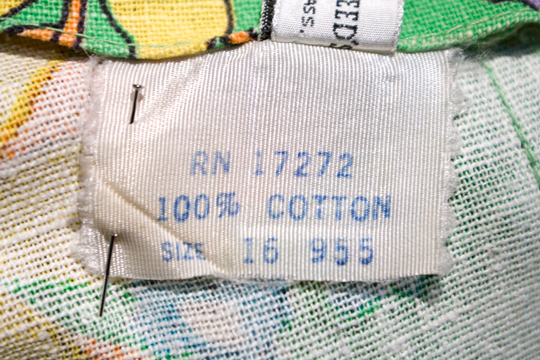
LOOK FOR … the presence of an RN number, which stands for Registered Identification Number. This is a number of five to six digits, preceded by “RN.”
HOW OLD?
1959 and earlier for numbers listed as 00101 to 04086 and post-1959 for numbers listed as 13670 or larger.
WHY IT’S VINTAGE:
The first RN numbers were issued in 1952 and ranged from 00101 (the lowest number) to 04086 (the highest number). In 1959, the numbering system changed, and the new numbers started from 13670. Therefore, you can estimate the age of a garment by comparing its RN number to 13670. For example, a label with RN 17272 would suggest that the garment was made in the mid-’60s.
HOWEVER, PLEASE NOTE:
RN numbers do NOT necessarily indicate the exact year a garment was made. They only indicate when the RN number was first issued for the business to use. So, a business could have used the same RN number for many years, even decades, without changing it.
This means that a ’70s dress could have a lower RN number than another ’70s dress of similar production time, depending on when the business obtained its RN number.
BEST RULE OF THUMB:
I’ve personally decided that RN numbers of 6+ digits are from the ’80s or later, while RN numbers of 5 digits are from the ’60s and ’70s. This is not a definitive method, but it can help you with identifying vintage clothing tags and labels you encounter.
RESOURCES: The WPL, RN & CA Labeling Guide on Ebay.
Vintage Clothing Label #9: LOT NUMBERS

LOOK FOR … the verbiage “lot”, usually followed by a number or number with a letter. This was a way to identify the batch or group of garments that were made from the same fabric or design.
HOW OLD?
Pre-1979.
Vintage clothes from the 1970s epitomize the bohemian spirit and eclectic style of the era. With bell-bottom pants, flowing maxi dresses, and paisley patterns, the fashion of the ’70s embraced freedom and self-expression. Platform shoes, tie-dye, and disco-inspired outfits remain iconic symbols of this groovy and transformative decade.
WHY IT’S VINTAGE:
Lot numbers were used to organize and track the production of clothing in factories, especially in the United States. They helped to ensure quality control, inventory management, and record keeping.
Lot numbers were discontinued around 1979, probably due to the globalization of the clothing industry and the emergence of new technologies. Therefore, if you see a label with a lot number, you can be confident that the garment is vintage, dating from before 1979.
Vintage Clothing Label #10: ODD NUMBER SIZES
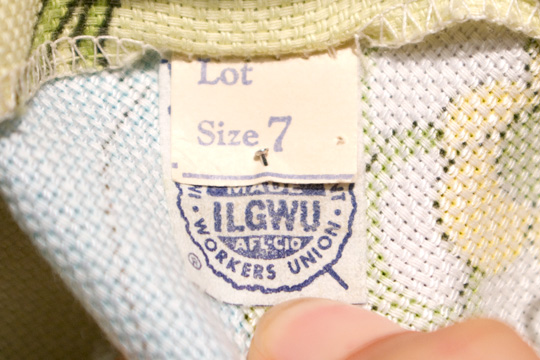
LOOK FOR … odd sizes, i.e. 3, 5, 7, 9.
One of the most confusing aspects of vintage clothing labels and tags is the use of odd number sizes. These sizes may seem familiar to modern shoppers, but they actually had a different meaning and purpose in the past.
HOW OLD?
Pre-1980s. Odd number sizes were originally created for petite women, not teenagers or pre-teens as they are today. Petite women had smaller and shorter body measurements than regular women and needed garments that fit their proportions better.
WHY IT’S VINTAGE:
Odd number sizes were used until the 1980s, when the clothing industry started to produce separate petite lines with more specific and varied sizing systems.
Odd sizing became more standard for pre-teen and teenage women of modern-day — remember the store 5-7-9? One of my favs growing up because all sizes were 5, 7, or 9!
Vintage Clothing Label #11: MADE IN MEXICO
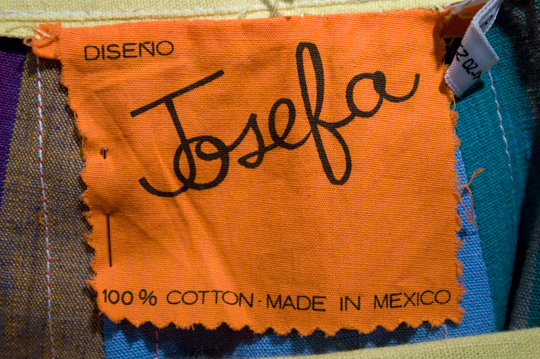
LOOK FOR … “Made in Mexico” verbiage.
HOW OLD?
The 1950s is the probable era of vintage garment that was Made in Mexico. This may seem like a generic and common label, but it actually has a specific and interesting history. The decade embraced playful novelty prints, like polka dots and floral patterns, while the 1960s saw a shift towards mod fashion, characterized by bold colors, geometric shapes, and miniskirts, embodying the era’s spirit of youthful rebellion and artistic experimentation.
WHY IT’S VINTAGE:
Although you can certainly buy modern clothing that was made in Mexico, vintage clothing made in Mexico is most likely from the 1950s.
The reason is that travel to Mexico was quite popular during the era for Americans. Many travelers bought Mexican clothing as souvenirs or gifts, especially the colorful and festive circle skirts that featured embroidery, applique, or sequins.
Mexican clothing also became fashionable in the United States, and many boutiques sold imported or inspired pieces. Mexican styles influenced the American fashion scene and added a touch of exoticism and flair.
NOTE:
However, this tag tip is not very reliable, as you can also find modern clothing that was made in Mexico. Therefore, you should only use this tip if you are already sure that the garment is vintage and not mistake a modern piece for a vintage one.
Also, for more vintage geographic know-how, read more about the influences of California & Hawaii in my Dating Clothing as Vintage article.
Vintage Clothing Label #12: CARE INSTRUCTIONS
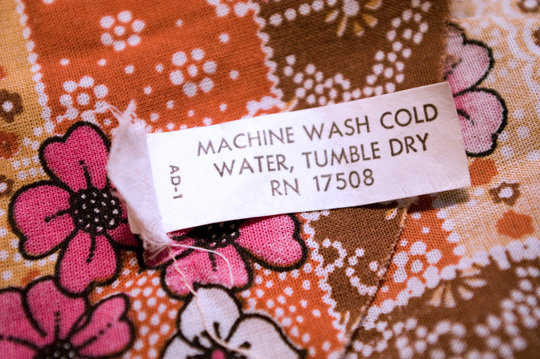
LOOK FOR … a care label or the lack thereof. A care label is a tag that tells you how to wash and maintain the garment, such as whether to machine wash, hand wash, dry clean, or iron it.
HOW OLD?
Care labels were not required by law until 1971 when the Federal Trade Commission issued the Care Labeling Rule. This rule mandated that all garments sold in the United States must have a care label with at least one method of cleaning.
Therefore, if you see a label with a care label, you can assume that the garment is from 1971 or later.
NOTE:
However, this tip is not foolproof, as some manufacturers may have voluntarily added care labels before 1971, or some garments may have lost their care labels over time. Therefore, vintage clothing collectors should always use other clues and vintage fashion tips to confirm the age of the garment.
WHY IT’S VINTAGE: Read more on how to date vintage by its care label here.
Vintage Clothing Label #13: UNION TAGS

LOOK FOR … a union tag, either from the International Ladies’ Garment Workers’ Union (ILGWU) or from one of the other 6 unions or union subgroups, including the Amalgamated Clothing Workers of America (ACWA) and the United Garment Workers of America (UGWA).
HOW OLD?
Typically 1920s to 1980s, depending on the tag design you’re looking at. For instance, The ILGWU label changed its design several times over the years, and each design can help you narrow down the age of the garment.
WHY IT’S VINTAGE:
Read more on identifying and dating the age of ILGWU union labels here, and how to date vintage clothing based on 6 other vintage union labels in addition to ILGWU here.
Vintage Clothing Label #14: MY NAME!
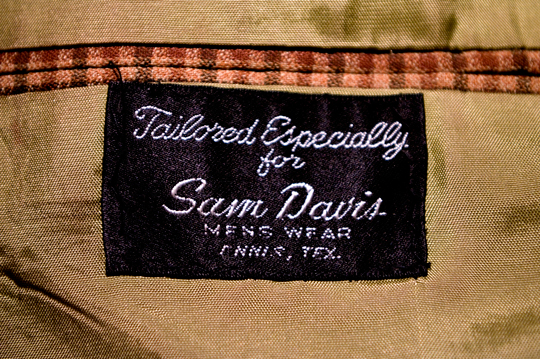
Oh … and that tag up there? How do I know it’s vintage? Well, because it has my name on it!
Although clearly for a male named Sam Davis, I just about died when I saw this tag on a men’s jacket in The Family Vintage Jewels, a wonderful thrift store that let us take photos of their vintage clothing tags.
So, Sam Davis, if you are reading this, your jacket is waiting for you! Or maybe I should keep it for myself?
Thank you to the Family Vintage Jewels for loaning vintage clothing for the creation of this article.

Zip codes weren’t invented until 1963?!? How did I not know this?? <–mind blown. Another bookmark-worthy post. I'm going to have to print this (along with the fabulous ILGWU Label Guide), sit down with ALL my vintage clothes, and compare the details of the labels. I'll let you know if I solve any vintage mysteries!
Natalie, you are my biggest support when it comes to these educational-based articles. Thank you!! I’ve done so many these past few weeks as I wrap my head around it all, too. I would LOVE to hear what you learn. Perhaps you have a piece that is older than you think. I have too found this, myself, now that I have more knowledge. What I thought was late ’60s is in fact early ’60s, vice versa. It makes a huge difference! Thank you Natalie!
Thanks Natalie! LOL I felt the same way about zip codes. There are lots of other history tidbits which will help you as a “fashion history detective.” I’m on the case!
Like Nathalie, I can’t wait to see what hidden gems I might have found along the ways! Thank you. I love these educational posts.
Such a great article!!
Just curious… how do you know that lot numbers were not used post 1979. I have definitely seen them on 80s clothing and possibly even later. I have been looking for a definitive answer on lot numbers for awhile.
Thanks
What a great site to reference. We were just talking about this today, with so many trends today looking retro but being newer this should help a lot!
Hello!
You mention that companies stopped using lot numbers before 1980. Could you provide me a source for that information, if possible?
I have a vintage item listed on Etsy that, for some reason, has been flagged as not being vintage, but it has a lot and style number and was made in the USA, etc etc, so it is clear to me that it is AT LEAST from the 1980s. However, Etsy requires a “reliable referral source” to confirm that a piece is vintage, so I’m wondering what source you used to find that information?
Love your site.
Wow, this piece of writing iѕ gooԁ, mу sisteг is analyzing these kinds οf
things, so I аm going to tell her.
My web blog yahoo autos
I am so happy that I have found your website. Your information is incredibly helpful in distinguishing union label era. Again, thanks.
Be Thrift! @ Beyond Thrift Boutique
Great post. I used to be checking constantly this weblog and I’m impressed! Very useful information specially the last phase :) I maintain such information a lot. I was seeking this particular information for a long time. Thanks and best of luck.
Thank you so much for your information…this has helped me so much in identifying vintage garments… again, thanks.
Such great news! Thank you Vivien! Be sure to subscribe to my newsletter for more on selling vintage fashion online if you aren’t subscribed already. #vintagelove
Does anyone here know anything about “tads” jeans/bell bottoms? I have a pair from the 70’s that are amazing and I cannot find any info online about them. I had a guy offer me 100$ bucks for them, and while I probably won’t get rid of them I would like to find out more. All I can tell is that they are an American brand. The internet fell short on this one!
Thanks for all the info…. I’m dating a drop waist ivory flower lace dress with rhinestone buttons.
Thanks so much for this article! I do have a question: if a garment is labeled with a lot number, does this mean it is definitely made before 1979? I have a Richard Warren top that has a lot number, but I’m pretty sure that that company wasn’t established until 1980 at least…
Clothing labels will ensure the son or girl can find their item after a fast trip to typically forgotten and additionally found.
Hi Sammy,,you are really great. You did a great research on vintage clothing tags..It’s a really resourceful and informative article..I learn lots of new information on vintage clothing tags here..It inspires me to learn more about vintage labels history…thanks for sharing the photos as well.
Fabulous information. So glad to discover you
Hi there,
I came across an amazing vintage hat today, I am very curious its age. The hat has the union made label with the smooshed globe followed by a 6 that you describe in detail, thank you for that. It also says “CO 824786”. Any idea what time period this may be from?
So happy to have found this fantastic website.
Thanks in advance for the help
This is super helpful! It really helped me with aging my vintage clothing so thankyou! I recently wrote a blog post myself about how to tell if clothing is truly vintage. It might help some people as well to age their clothing. :) – http://florencemayvintage.blogspot.co.uk/2015/03/how-to-tell-if-clothing-is-vintage.html
Daisy x
I got a dress at a thrift store. The brand is Charter Club, which seems like a modern brand, but it has a WPL number on the label. How old is it? It looks new, and it’s a shift dress.
Charter Club is an inhouse Macy’s brand…..not particularly expensive or well made.
Hi, Sammy! Love your page! I am an enthusiastic collector (and wearer!) of vintage pretties. I recently ran across a label on an embellished denim jacket with a registered trademark that, unfortunately, is difficult to decipher. I wonder if you, or some of the other vintage-lovers, might recommend the best way to go about identifying it. I’m pretty good with puzzles but this one has me stumped.
Thanks for your good help!
Suzanne
I have an Alberto Makali dress that is tricky. It has a label with New York Paris Milano on it. The inside fabric tag says made in USA, There is a fabric called poliamide. It has instructions to dry clean only, but there is what looks to be an rn# that is only 5 digits 55405 and the dress has a 90’s does 40’s vibe. I am so confused. Please help.
Ugh so much nisinformatiion here. The lot number explantion, for example. Is shown on a size tag which is over a union tag. The UNION tag is clearly pre mid 1970s, based on the color, blue and white.
If you researched and put so much effort into an article and provided pictures galore on this topic, I hope anyone who might have a correction or critique would share constructively. We all need encouragement. Your first sentence reads as harsh. Please do share your knowledge on this cool topic with us, but in a way that informs us about vintage labels and not just about your disagreement.
Tanya might have been harsh but she is correct Scroll up, see the copyright date of 1982 on the Cassadi dress and also note the lot number tag attached to the dress.
Great resource. Thank you. Identifying vintage clothing has always been the hardest thing for me, and this is certainly a great first step for me. Thanks again.
Yes!! We started a vintage resale and we accidentally grabbed a couple of fake pieces. We are currently brushing up on tag knowledge so we can avoid this in the future. Thanks for the post definitely going to revisit this on our thrift runs haha!!
Lot numbers did not cease use around 1979, as can be seen by your Casadei label posted on this same page showing clearly a copyright date of 1982 and a lot number tag. In fact, lot numbers are found for many decades following 1982. Please correct that information as many readers actually misdate clothing due to that misinformation.
Celanese was considered basically rayon, no? It ISN’T rayon, it’s acetate, but both are cellulose-based synthetics. It was popular much earlier than polyester.
(You probably know that, but the organization of the fabric content section implies that Celanese is a marketing name for polyester, and it isn’t.)
Thank you for the great article!
HOW OLD? Pre-1999, considering the British Colony of Hong Kong gained its independence before the dawn of the new millennium.
Hong Kong did not gain its independence.
Its under the control Communist China, the most murderous regime the world has ever known.
According to the FTC, RN system has been in place since the 1940s: https://www.ftc.gov/news-events/news/press-releases/1997/12/registered-identification-numbers-rns.
So why does your article state they were first in use in 1952?
I am a not truly vintage clothing reseller. But sometimes I am able to land a vintagy piece. I am currently trying to date a Bill Blass Silk aloha shirt. I think it is 90’s but it’s a little hard to tell. I was wondering if laundry care symbols can be used to get a rough time frame for garments. I have done a little looking, and there doesn’t seem to be a place to compare the garment symbol changes that have occurred since their US adoption in 1993. I keep seeing the revisions mentioned, but can’t find out just what these revisions were. Is there a difference in the US care symbology between 1993 and today, and if so, what are these revisions? For example, when did the US adopt the temperature dot system vs the listing of max temps in Centigrade? My shirt has the tub with a 30 degree and two underlines (gentle hand wash). Would that be also done today?
Thank you so much for these articles!!! I was struggling before finding these. Wowsas! So I found a wedding dress with only 2 tags attached to the back left inside collar: a red tag “Lot Size 7” and beneath it a longer white tag that says “DRY CLEAN ONLY” with “MADE IN U.S.A.” under the latter. It looks almost exactly like a Gunne Sax version made in 70s/80s (?): all lace with inner lining except for the long sleeves; drop waist; bibbed; shoulder pads; covered back zipper. I’ve inspected the dress till my eyes bled; I’m confident no other tags were attached or cut off. There are no material labels either. Any thoughts on what era this could possibly be from? Many thanks!
So if there is no information on a garment, but an embordered logo of a crown on a back pocket how do you identify the maker?
10/26/24: Hi! I just found your site – great information. However, regarding your comment “Odd number sizes were originally created for petite women, not teenagers or pre-teens as they are today,” I beg to differ. I’m a tall woman (approx. 5’10”) and clothing I bought in the 1970s (and late 1960s) when I was a tall teenager, were size 9 or 11 or rarely 13, which was the largest odd number size I remember. I still have a lot of that clothing, some of which my adult daughters now where!